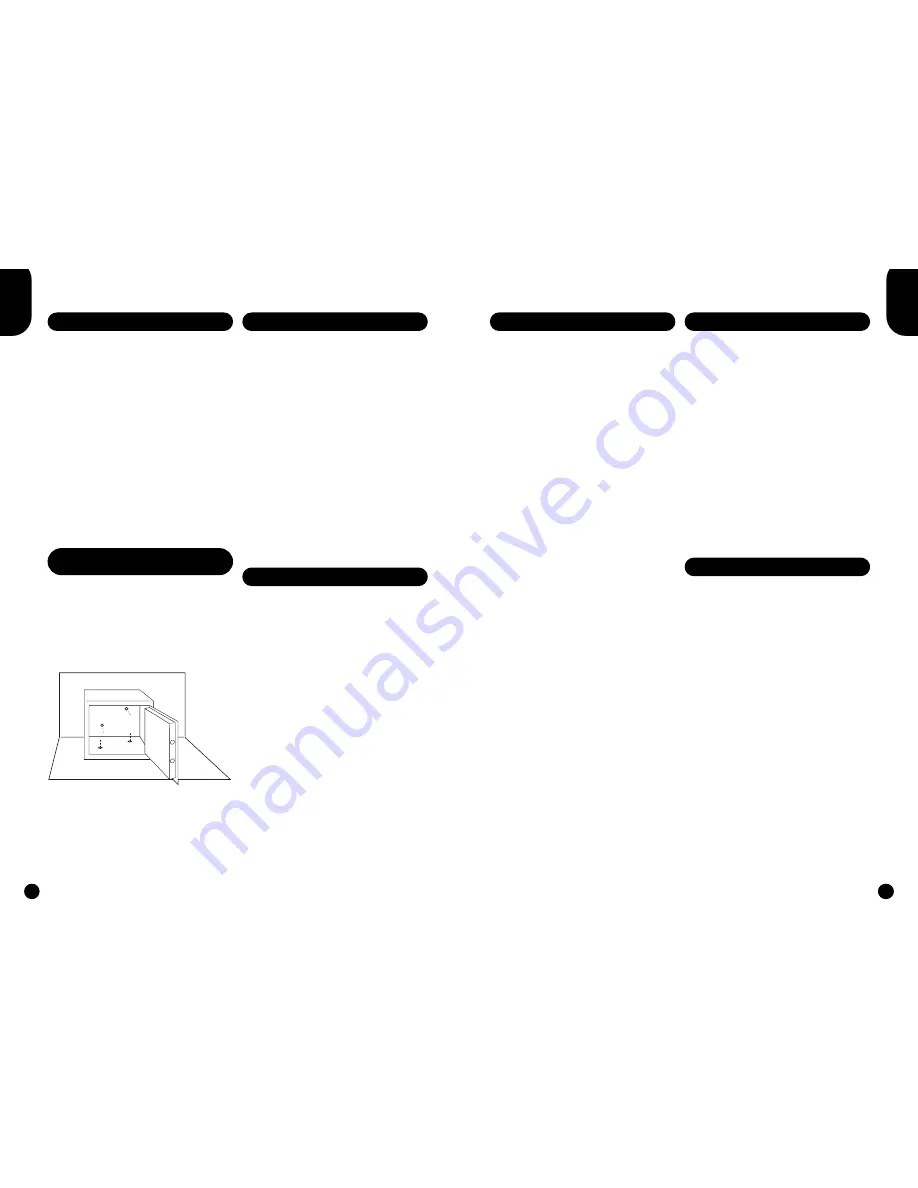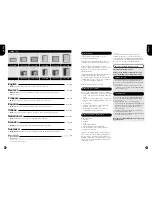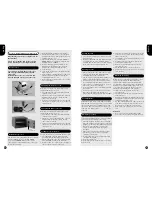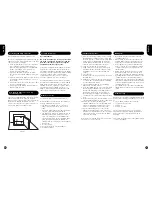
Installation instructions
1. Place the safe in the position you have selected.
Before marking or drilling any holes ensure that
there are no pipes or cables present at the fixing
points. If there is skirting board present at the
desired fixing point, this should be removed to
allow the safe to be fitted flush to the wall.
2. Open the safe and remove any shelves.
3. Using a pencil or a sharp object, mark out the
four drill holes; two on the floor and two on the
wall. (Always try to secure the safe with four
screws).
4. Close the safe.
5. Now move the safe to give enough room to drill
the fixing holes.
6. Drill holes: you will need the concrete drill bit for
a concrete base material, and the wood drill bit
for a wooden base material.
7. Clear the drill holes and remove any drilling
debris using a vacuum cleaner.
8. If you have drilled holes in a concrete floor, insert
the plastic plugs supplied in the holes. Ensure
that the end of the plug is level with the edge of
the drill hole. If necessary, use a hammer to
insert the plug. The plugs are not used when
securing the safe to wooden floor and/or wooden
wall.
9. Now position the safe so that the fixing holes on
safe match the drill holes in the floor and/or wall.
10.Secure the safe using the fixing screws
supplied. Slide the washer over the fixing screw
before screwing it into the drill hole. You will
need a socket wrench to drive in the screw.
11.On a double-walled safe, you can cover the
fixing holes with the plastic covers. This is not
possible on a single-walled safe. The two plastic
caps can be used to cover any unused fixing
holes from the outside.
However, we recommend that you do not use just
two screws to secure your safe.
Maintenance
• Never throw your keys. Distortion of the key
can damage the lock.
• When closing the door, there should never be
anything between the door and the safe (e.g. a
paper clip). The bolts must be fully retracted.
• Do not fill the safe to such an extent that it is
hard to close the door. The locking mechanism
could then seize up as a result of pressure on
the inner plate.
• Ensure that the key in the door does not hit a
wall when opening. This can cause the key to
snap, and can damage the locking mechanism.
• If you find that the lock becomes harder to open
or stiffer, never use oil or graphite powder to
'lubricate' the lock. This can make the tumblers
sticky, which could prevent the lock from opening
at all. Your supplier can advise you on the correct
cleaning product to use.
• The outside of your safe can be cleaned with a
slightly damp cloth. Never use chemical cleaning
agents.
Troubleshooting
Although your safe has been manufactured with the
greatest care, a fault may nevertheless occur, such
as:
• The locking mechanism does not work.
• You cannot open your safe.
• Faulty lock.
• You lose your key.
The most important rule is not to try and force
anything. The locking mechanism in particular is
made of precision components which can be
damaged.
First re-read the manual. If you cannot find a solution,
contact your supplier.
06
07
Securing instructions
Recommendation
We recommend that you secure your safe with
the screws provided to both the floor and the
wall. This offers the best protection against
unauthorised removal of your safe.
Your safe is equipped with four fixing holes for this
purpose: two in the bottom and two in the back.
The quality of the fixing is dependent on the quality
and nature of the floor and wall into which the fixing
screws are screwed. The best results will be
achieved if you place the safe on a concrete or
stone floor against a concrete or stone wall.
If you wish to install it on a wooden floor it may be
desirable to use different fixings to ensure optimum
fixing strength. Various types of anchor bolts are
available for use in wood which can give a better
result that the screws supplied. The choice of
fixings is largely determined by the thickness and
type of wood on which the safe is placed.
What do you need?
To secure the safe you need fixings and tools.
Before starting to secure the safe, check that you
have the following items to hand:
1. The fixing set supplied. This set consists of:
fixing screws, metal washers, plastic covers /
caps.
2. An electric (hammer) drill. If the base material is
concrete, you will need a hammer drill.
3. The fixing holes in the base material need to be
drilled first. If the base material is concrete or
stone, you will need a concrete drill bit. If the
base material is wood, use wood drill bit. Note:
you may therefore require both drill bits, for
example if the floor is made of concrete and the
wall is wood.
4. A socket wrench.
5. A vacuum cleaner to clear the drill holes.
6. Possibly a hammer.
Positioning and fixing of the safe
Where should I place my free-standing safe?
No safe is completely thief-proof. With time and the
right tools any safe can be broken into, so it makes
sense to observe the following:
1. It is important that the safe is as inconspicuous
as possible. We recommend that you never
place the safe anywhere where it is visible from
outside. For example, place your safe in a
cupboard or in the utility room.
2. If you have electronic security i.e. an alarm,
the safe is best positioned within the protected
room.
3. Place the safe with the hinge away from the wall
as this makes it harder to try the door open on
the lock side.
4. Position the safe as near to the floor as possible
in case of outbreak of fire.
5. Keep keys and combination numbers hidden
and away from the safe.
How and with what can I secure my
free-standing safe?
Your safe is equipped with two holes in the bottom
and two holes in the back. Using the supplied
fixings, you can secure the safe to the floor and/or to
the wall. For a detailed description of how to
secure your safe, please see figure 1. This gives a
step by step guide to securing the safe.
English
English
Figure 1
Содержание Trend 1-18K
Страница 1: ...www chubb safe co uk 0800 612 9456 ...













